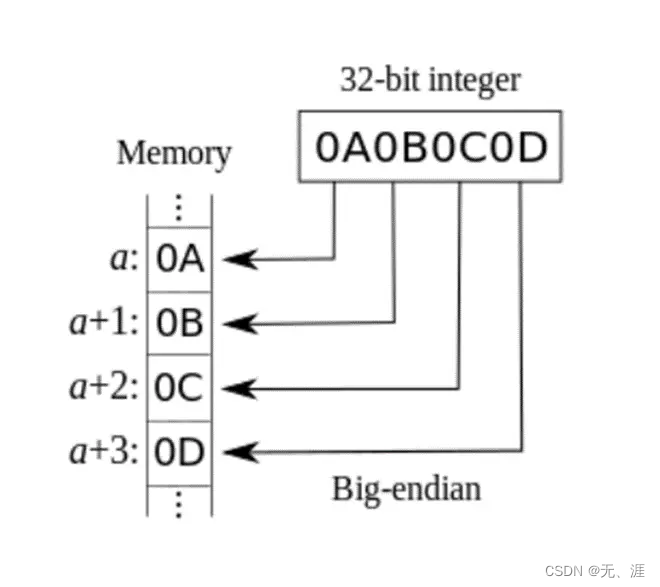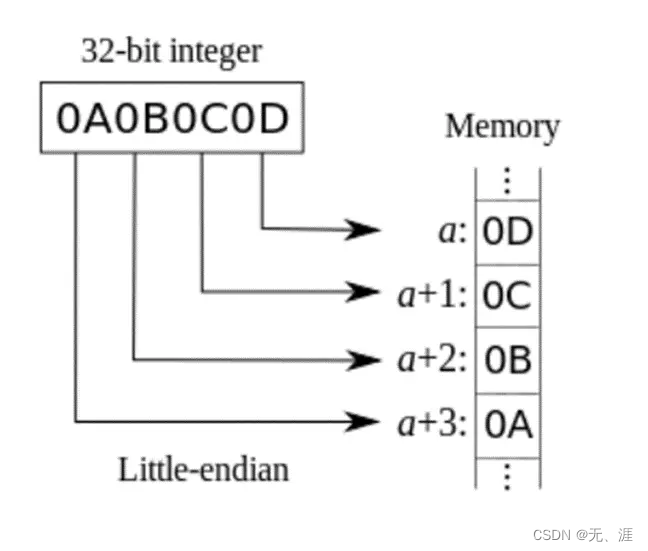转载 https://www.jianshu.com/p/37eb3b989e5d
Java中byte与short、int、long互转(包含大端,小端)
/**
* 将int转为高字节在前,低字节在后的byte数组(大端)
* @param n int
* @return byte[]
*/
public static byte[] intToByteBig(int n) {
byte[] b = new byte[4];
b[3] = (byte) (n & 0xff);
b[2] = (byte) (n >> 8 & 0xff);
b[1] = (byte) (n >> 16 & 0xff);
b[0] = (byte) (n >> 24 & 0xff);
return b;
}
/**
* 将int转为低字节在前,高字节在后的byte数组(小端)
* @param n int
* @return byte[]
*/
public static byte[] intToByteLittle(int n) {
byte[] b = new byte[4];
b[0] = (byte) (n & 0xff);
b[1] = (byte) (n >> 8 & 0xff);
b[2] = (byte) (n >> 16 & 0xff);
b[3] = (byte) (n >> 24 & 0xff);
return b;
}
/**
* byte数组到int的转换(小端)
* @param bytes
* @return
*/
public static int bytes2IntLittle(byte[] bytes )
{
int int1=bytes[0]&0xff;
int int2=(bytes[1]&0xff)<<8;
int int3=(bytes[2]&0xff)<<16;
int int4=(bytes[3]&0xff)<<24;
return int1|int2|int3|int4;
}
/**
* byte数组到int的转换(大端)
* @param bytes
* @return
*/
public static int bytes2IntBig(byte[] bytes )
{
int int1=bytes[3]&0xff;
int int2=(bytes[2]&0xff)<<8;
int int3=(bytes[1]&0xff)<<16;
int int4=(bytes[0]&0xff)<<24;
return int1|int2|int3|int4;
}
/**
* 将short转为高字节在前,低字节在后的byte数组(大端)
* @param n short
* @return byte[]
*/
public static byte[] shortToByteBig(short n) {
byte[] b = new byte[2];
b[1] = (byte) (n & 0xff);
b[0] = (byte) (n >> 8 & 0xff);
return b;
}
/**
* 将short转为低字节在前,高字节在后的byte数组(小端)
* @param n short
* @return byte[]
*/
public static byte[] shortToByteLittle(short n) {
byte[] b = new byte[2];
b[0] = (byte) (n & 0xff);
b[1] = (byte) (n >> 8 & 0xff);
return b;
}
/**
* 读取小端byte数组为short
* @param b
* @return
*/
public static short byteToShortLittle(byte[] b) {
return (short) (((b[1] << 8) | b[0] & 0xff));
}
/**
* 读取大端byte数组为short
* @param b
* @return
*/
public static short byteToShortBig(byte[] b) {
return (short) (((b[0] << 8) | b[1] & 0xff));
}
/**
* long类型转byte[] (大端)
* @param n
* @return
*/
public static byte[] longToBytesBig(long n) {
byte[] b = new byte[8];
b[7] = (byte) (n & 0xff);
b[6] = (byte) (n >> 8 & 0xff);
b[5] = (byte) (n >> 16 & 0xff);
b[4] = (byte) (n >> 24 & 0xff);
b[3] = (byte) (n >> 32 & 0xff);
b[2] = (byte) (n >> 40 & 0xff);
b[1] = (byte) (n >> 48 & 0xff);
b[0] = (byte) (n >> 56 & 0xff);
return b;
}
/**
* long类型转byte[] (小端)
* @param n
* @return
*/
public static byte[] longToBytesLittle(long n) {
byte[] b = new byte[8];
b[0] = (byte) (n & 0xff);
b[1] = (byte) (n >> 8 & 0xff);
b[2] = (byte) (n >> 16 & 0xff);
b[3] = (byte) (n >> 24 & 0xff);
b[4] = (byte) (n >> 32 & 0xff);
b[5] = (byte) (n >> 40 & 0xff);
b[6] = (byte) (n >> 48 & 0xff);
b[7] = (byte) (n >> 56 & 0xff);
return b;
}
/**
* byte[]转long类型(小端)
* @param array
* @return
*/
public static long bytesToLongLittle( byte[] array )
{
return ((((long) array[ 0] & 0xff) << 0)
| (((long) array[ 1] & 0xff) << 8)
| (((long) array[ 2] & 0xff) << 16)
| (((long) array[ 3] & 0xff) << 24)
| (((long) array[ 4] & 0xff) << 32)
| (((long) array[ 5] & 0xff) << 40)
| (((long) array[ 6] & 0xff) << 48)
| (((long) array[ 7] & 0xff) << 56));
}
/**
* byte[]转long类型(大端)
* @param array
* @return
*/
public static long bytesToLongBig( byte[] array )
{
return ((((long) array[ 0] & 0xff) << 56)
| (((long) array[ 1] & 0xff) << 48)
| (((long) array[ 2] & 0xff) << 40)
| (((long) array[ 3] & 0xff) << 32)
| (((long) array[ 4] & 0xff) << 24)
| (((long) array[ 5] & 0xff) << 16)
| (((long) array[ 6] & 0xff) << 8)
| (((long) array[ 7] & 0xff) << 0));
}
大端和小端
举一个例子,比如数字0x12 34 56 78在内存中的表示形式。
1)大端模式:Big-Endian就是高位字节排放在内存的低地址端,低位字节排放在内存的高地址端。(其实大端模式才是我们直观上认为的模式,和字符串存储的模式差类似)即正序排列,高尾端;
低地址 --------------------> 高地址
0x0A | 0x0B | 0x0C | 0x0D

2)小端模式:Little-Endian就是低位字节排放在内存的低地址端,高位字节排放在内存的高地址端。即逆序排列,低尾端;
低地址 --------------------> 高地址
0x0D | 0x0C | 0x0B | 0x0A

无论是小端模式还是大端模式,每个字节内部都是按顺序排列。
一般操作系统都是小端,而通讯协议是大端的。
实际中的例子
虽然很多时候,字节序的工作已由编译器完成了,但是在一些小的细节上,仍然需要去仔细揣摩考虑,尤其是在以太网通讯、MODBUS通讯、软件移植性方面。这里,举一个MODBUS通讯的例子。在MODBUS中,数据需要组织成数据报文,该报文中的数据都是大端模式,即低地址存高位,高地址存低位。假设有一16位缓冲区m_RegMW[256],因为是在x86平台上,所以内存中的数据为小端模式:m_RegMW[0].low、m_RegMW[0].high、m_RegMW[1].low、m_RegMW[1].high……
为了方便讨论,假设m_RegMW[0] = 0x3456; 在内存中为0x56、0x34。
现要将该数据发出,如果不进行数据转换直接发送,此时发送的数据为0x56,0x34。而Modbus是大端的,会将该数据解释为0x5634而非原数据0x3456,此时就会发生灾难性的错误。所以,在此之前,需要将小端数据转换成大端的,即进行高字节和低字节的交换,此时可以调用步骤五中的函数BigtoLittle16(m_RegMW[0]),之后再进行发送才可以得到正确的数据。
& 0xff 的作用
取得低八位
通常配合移位操作符>>使用





















 8281
8281











 被折叠的 条评论
为什么被折叠?
被折叠的 条评论
为什么被折叠?








